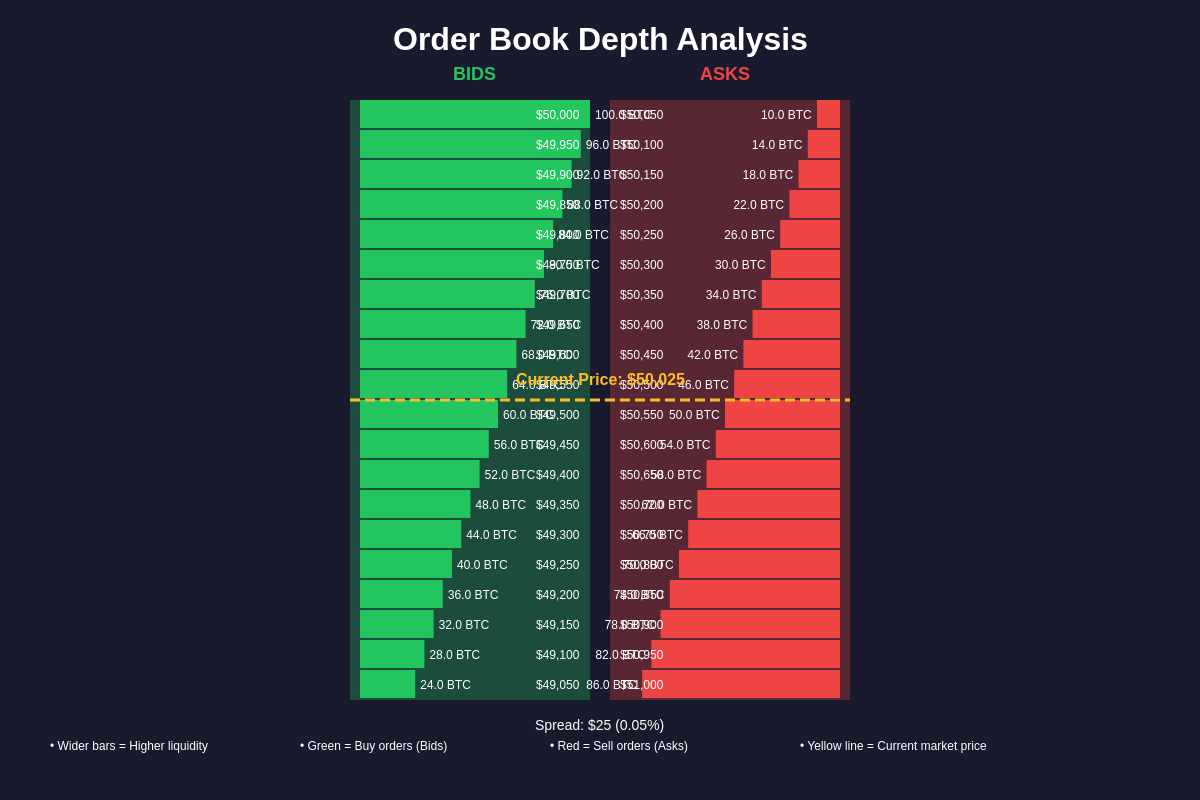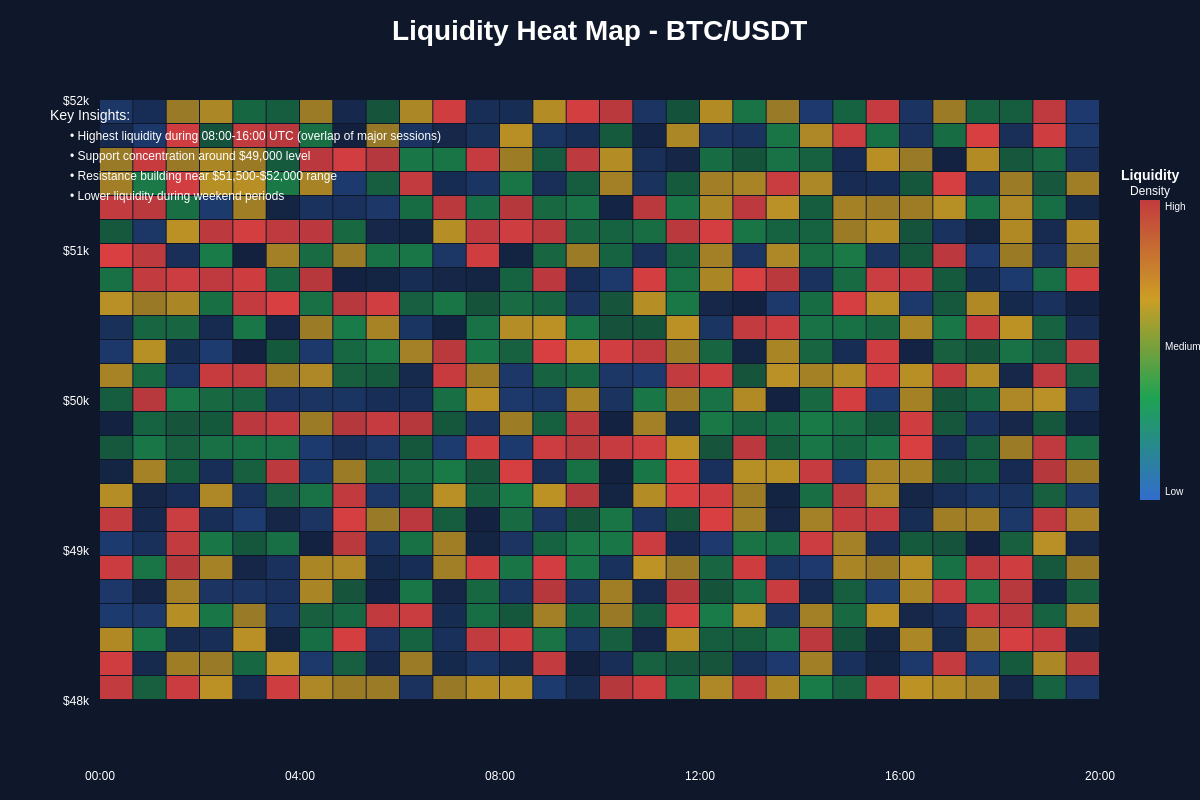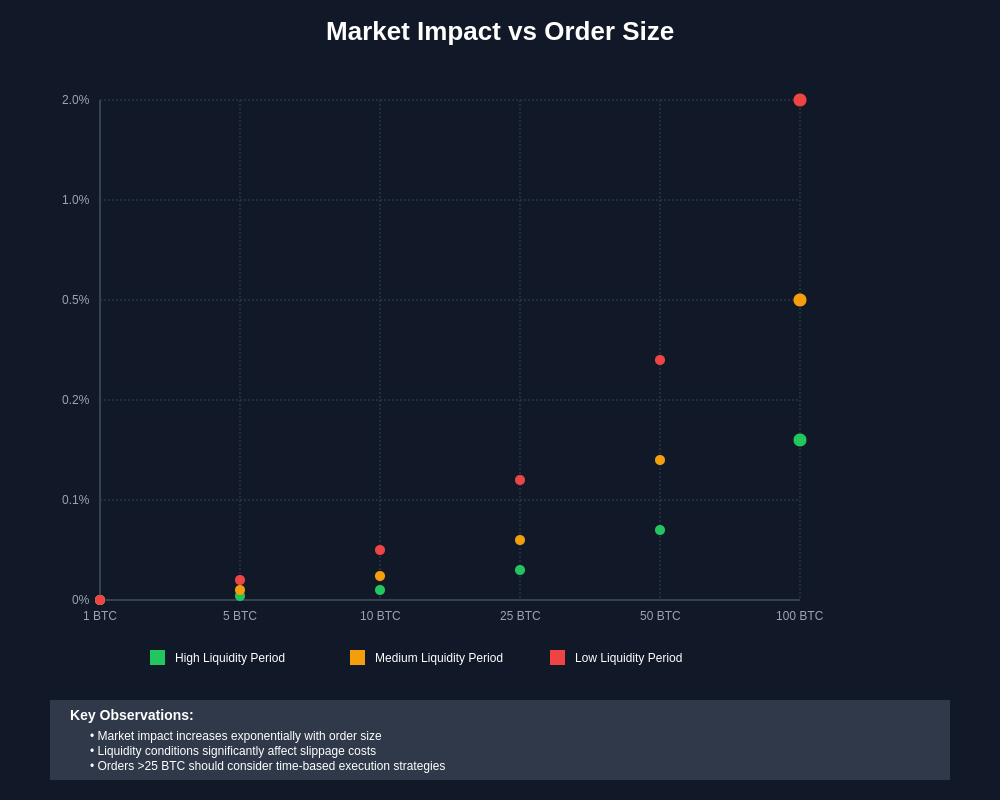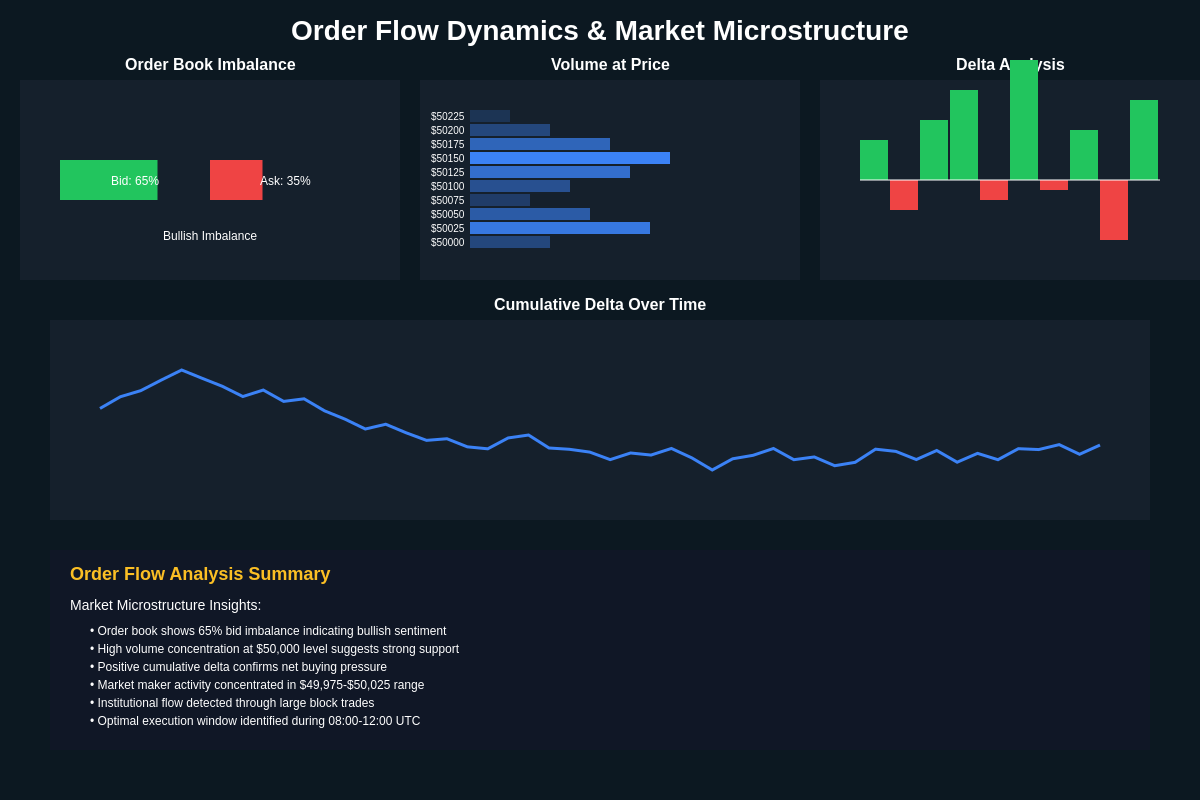Discover advanced trading analytics and order book visualization tools on TradingView
Understanding Order Book Fundamentals
Order book depth analysis represents one of the most critical skills for cryptocurrency traders seeking to understand true market liquidity and identify optimal entry and exit points for their positions. The order book serves as a real-time snapshot of market sentiment, displaying all pending buy and sell orders at various price levels and providing invaluable insights into supply and demand dynamics that drive price movement in cryptocurrency markets.
The fundamental structure of an order book consists of bid orders representing buyers willing to purchase assets at specific prices and ask orders representing sellers looking to dispose of their holdings at particular price points. The spread between the highest bid and lowest ask creates the bid-ask spread, which serves as a primary indicator of market liquidity and trading costs that traders will incur when executing market orders.
Understanding order book depth requires analyzing not just the best bid and ask prices, but examining the full spectrum of orders at various price levels to assess the true depth of liquidity available in the market. Shallow order books with limited depth can result in significant slippage for larger orders, while deep order books with substantial liquidity at multiple price levels provide better execution quality for traders of all sizes.

Market makers play a crucial role in order book dynamics by continuously providing liquidity through limit orders placed at various price levels around the current market price. These participants profit from the bid-ask spread while providing essential liquidity that enables efficient price discovery and reduces transaction costs for other market participants seeking to execute trades.
Technical Indicators for Depth Analysis
Professional traders employ sophisticated technical indicators specifically designed to analyze order book depth and identify potential trading opportunities based on liquidity imbalances and market microstructure patterns. These indicators go beyond simple price and volume analysis to examine the underlying supply and demand forces that drive short-term price movements in cryptocurrency markets.
Volume at price analysis examines the cumulative trading volume that has occurred at different price levels over specific time periods, helping traders identify significant support and resistance levels where substantial trading activity has historically taken place. High volume nodes often represent areas where price may find support or encounter resistance due to the concentration of market participants with positions established at those levels.
Order flow analysis tracks the real-time flow of buy and sell orders entering and leaving the order book, providing insights into the aggressive buying or selling pressure that may precede significant price movements. Advanced order flow tools available on TradingView enable traders to visualize these patterns and identify potential momentum shifts before they become apparent in traditional price charts.
Market depth indicators measure the total value of buy and sell orders at various distances from the current market price, helping traders assess the potential impact of their orders on market prices and identify optimal position sizing strategies. These indicators become particularly valuable when trading larger positions that could significantly impact market prices if executed without careful consideration of available liquidity.
Imbalance ratios compare the total value of buy orders to sell orders at different price levels, revealing potential directional bias in market sentiment that may lead to price movements as the market seeks to balance supply and demand forces. Significant imbalances often precede breakout movements as the market responds to concentrated buying or selling pressure.

Market Making and Liquidity Provision
The ecosystem of market making in cryptocurrency exchanges involves complex interactions between algorithmic trading systems, institutional liquidity providers, and retail traders, all contributing to the overall depth and stability of order books across different trading pairs and market conditions. Understanding these dynamics helps traders better interpret order book signals and make more informed trading decisions.
Algorithmic market makers utilize sophisticated strategies to continuously provide liquidity while managing inventory risk and capturing profits from bid-ask spreads. These systems dynamically adjust their order placement based on market volatility, trading volume, and other factors that influence optimal market making parameters, creating patterns in order book behavior that experienced traders can recognize and potentially exploit.
Institutional liquidity providers often operate with different objectives than retail market makers, focusing on longer-term inventory management and risk mitigation rather than short-term profit maximization. Their presence in order books typically results in deeper liquidity at key price levels but may also create predictable patterns that sophisticated traders can identify and incorporate into their trading strategies.
The interaction between different types of market participants creates complex order book dynamics that vary significantly across different cryptocurrency exchanges, trading pairs, and market conditions. Exchanges with higher trading volumes and more diverse participant bases typically exhibit more stable and predictable order book behavior, while smaller exchanges may experience more erratic liquidity patterns.
Cross-exchange arbitrage activities also influence order book depth as traders simultaneously execute orders across multiple platforms to capture price discrepancies. These activities tend to improve overall market efficiency but can also create temporary liquidity imbalances as arbitrage capital flows between different trading venues.
Reading Order Book Signals
Developing proficiency in reading order book signals requires understanding the subtle patterns and behaviors that indicate potential price movements before they become apparent through traditional technical analysis methods. Experienced traders learn to recognize specific order book configurations that historically precede significant market moves.
Large order walls represent concentrations of buy or sell orders at specific price levels that can act as significant support or resistance barriers. However, these walls can be misleading as they may be withdrawn before price reaches those levels, or they may represent iceberg orders where only a portion of the total order size is visible in the order book at any given time.
Spoofing patterns involve the placement of large orders with the intention of creating false impressions of market depth, only to cancel these orders before execution. Recognizing these manipulative practices helps traders avoid making decisions based on misleading order book information and identify genuine liquidity versus artificial market signals.
Order book flashing occurs when large orders appear and disappear rapidly from the order book, potentially indicating algorithmic trading activity or market participants testing market reactions to large order placements. These patterns can provide insights into the presence of institutional trading activity and potential future price direction.
The speed and manner in which orders are filled provides valuable information about market urgency and the likelihood of continued price movement in the same direction. Rapid consumption of order book liquidity often indicates strong momentum that may continue until sufficient opposing liquidity emerges to balance market forces.
Slippage and Execution Quality
Understanding slippage mechanics and execution quality becomes critical for traders executing larger positions or operating in markets with limited liquidity, as poor execution can significantly impact trading profitability regardless of the accuracy of market timing and direction predictions. Effective slippage management requires careful analysis of order book depth and strategic order execution techniques.
Price impact analysis involves calculating the expected price movement that would result from executing orders of various sizes against current order book liquidity. This analysis helps traders determine optimal position sizing and execution strategies that minimize market impact while achieving desired exposure to specific cryptocurrency assets.
Time-weighted average price strategies involve breaking large orders into smaller components executed over extended time periods to reduce market impact and achieve more favorable average execution prices. The effectiveness of these strategies depends heavily on current order book depth and the rate at which new liquidity enters the market.
Implementation shortfall analysis compares actual execution results to theoretical benchmark prices to assess the quality of order execution and identify areas for improvement in trading processes. This analysis becomes particularly valuable for traders executing larger positions where execution quality significantly impacts overall trading performance.
Market timing considerations for order execution involve identifying periods when order book depth is typically higher and market impact is minimized. Many cryptocurrency markets exhibit predictable patterns in liquidity throughout different time periods, with higher liquidity often coinciding with overlap between major trading sessions.

Cross-Exchange Liquidity Analysis
The fragmented nature of cryptocurrency trading across multiple exchanges creates opportunities for traders who understand how to analyze liquidity across different platforms and identify optimal execution venues for their trading strategies. Cross-exchange analysis reveals significant differences in order book depth, pricing efficiency, and execution quality that can impact trading results.
Exchange-specific liquidity patterns vary based on factors including user base composition, trading fee structures, available trading pairs, and geographical regulatory considerations. Larger exchanges typically offer deeper liquidity but may also attract more sophisticated competition, while smaller exchanges might provide opportunities for more favorable execution in specific market conditions.
Arbitrage opportunity identification requires real-time monitoring of order books across multiple exchanges to identify temporary price discrepancies that can be exploited through simultaneous buying and selling activities. Professional arbitrage tools and analytics are available through TradingView’s comprehensive platform, enabling traders to monitor multiple markets efficiently.
Latency considerations become critical when executing cross-exchange strategies, as the speed of data transmission and order execution can determine the profitability of arbitrage opportunities. Geographic proximity to exchange data centers and the quality of internet connectivity can significantly impact the ability to capture fleeting arbitrage opportunities.
Regulatory differences between exchanges operating in different jurisdictions can create structural arbitrage opportunities that persist for extended periods. Understanding these regulatory factors helps traders identify longer-term arbitrage strategies that do not rely solely on execution speed but rather on market structure differences.
Advanced Depth Indicators
Sophisticated traders utilize advanced depth indicators that go beyond basic order book visualization to provide deeper insights into market microstructure and potential price movements. These indicators often combine order book data with other market metrics to create comprehensive pictures of market conditions and trading opportunities.
Volume profile analysis examines the distribution of trading volume across different price levels over specified time periods, revealing areas where significant trading activity has occurred and potentially identifying future support and resistance levels. This analysis helps traders understand where institutional players have established positions and where future price reactions might occur.
Delta analysis tracks the difference between buying and selling volume at the bid and ask prices, providing insights into the aggressiveness of market participants and potential short-term price direction. Sustained positive or negative delta can indicate building momentum that may lead to significant price movements as market sentiment becomes more pronounced.
Cumulative volume delta combines delta analysis over extended periods to identify longer-term trends in buying and selling pressure that may not be immediately apparent from short-term order book analysis. This indicator helps traders align their short-term execution strategies with longer-term market trends and institutional flows.
Liquidity heat maps visualize order book depth across multiple price levels and time periods, enabling traders to identify patterns in liquidity provision and consumption that can inform optimal entry and exit timing. These visualizations often reveal recurring patterns that can be incorporated into systematic trading strategies.
Institutional vs Retail Flow Patterns
The ability to distinguish between institutional and retail trading flows through order book analysis provides valuable insights into market dynamics and potential future price movements. Institutional trading typically exhibits different patterns in terms of order size, timing, and execution strategies compared to retail trading activity.
Institutional order characteristics often include larger average order sizes, more sophisticated execution strategies that minimize market impact, and timing patterns that coincide with institutional trading schedules and market sessions. Recognizing these patterns helps traders understand when institutional capital is entering or exiting positions.
Retail trading patterns typically involve smaller order sizes, less sophisticated execution strategies, and timing that often correlates with major news events or emotional market reactions. Understanding retail behavior helps traders anticipate potential market inefficiencies and identify opportunities for more favorable execution.
Block trading activities involve large institutional transactions that may be executed outside of public order books through dark pools or other private trading networks. However, the market impact of these transactions often becomes apparent through subsequent order book changes and price movements that traders can learn to recognize.
High-frequency trading activity creates specific patterns in order book behavior including rapid order placement and cancellation, minimal order sizes designed to test market conditions, and execution strategies focused on capturing small price discrepancies. Understanding these patterns helps traders avoid being adversely selected by sophisticated algorithmic trading systems.

Market Manipulation Detection
Order book analysis serves as a powerful tool for detecting various forms of market manipulation that can significantly impact trading decisions and overall market integrity. Understanding common manipulation techniques helps traders protect themselves from adverse selection and identify potentially profitable opportunities when manipulation creates temporary market inefficiencies.
Wash trading detection involves identifying patterns where the same entity or related entities execute trades with themselves to create artificial volume and price movement. These patterns often become apparent through unusual order book behaviors including perfectly matching buy and sell orders or statistical anomalies in trading patterns.
Pump and dump schemes typically involve coordinated buying pressure designed to artificially inflate prices before large-scale selling begins. Order book analysis can reveal the artificial nature of these movements through analysis of order sizes, timing patterns, and the relationship between order book depth and actual trading volume.
Spoofing identification requires recognizing patterns where large orders are placed and subsequently cancelled before execution, creating false impressions of market depth and potentially influencing other traders’ decisions. Advanced detection systems can identify these patterns through statistical analysis of order placement and cancellation behaviors.
Market cornering attempts involve accumulating large positions with the intention of controlling price movements through manipulation of available supply. Order book analysis can reveal early signs of these activities through unusual accumulation patterns and changes in normal liquidity provision behaviors.
Real-Time Monitoring Systems
Effective order book depth analysis requires sophisticated real-time monitoring systems capable of processing large volumes of market data and presenting actionable insights to traders in formats that enable quick decision-making. Modern trading platforms provide various tools and interfaces designed to support this type of analysis.
Data feed quality becomes critical for accurate order book analysis, as delayed or incomplete information can lead to incorrect conclusions about market conditions and result in poor trading decisions. Professional-grade data feeds typically provide microsecond-level timestamp accuracy and comprehensive order book depth information.
Alert systems enable traders to monitor multiple markets simultaneously and receive notifications when specific order book conditions are met, such as significant changes in liquidity depth, large order appearances, or unusual trading patterns. TradingView’s alert functionality provides comprehensive monitoring capabilities for cryptocurrency markets.
Visualization tools help traders quickly comprehend complex order book information through graphical representations including heat maps, depth charts, and time-based liquidity analysis. Effective visualization can significantly improve decision-making speed and accuracy in fast-moving market conditions.
API integration capabilities allow sophisticated traders to develop custom analysis tools and automated trading systems that can process order book information and execute trades based on predefined criteria. These systems enable more systematic approaches to order book analysis and can operate continuously without human intervention.
Strategy Development and Backtesting
Developing profitable trading strategies based on order book depth analysis requires systematic approaches to strategy development, rigorous backtesting methodologies, and continuous refinement based on changing market conditions and technological developments in cryptocurrency trading infrastructure.
Historical order book data provides the foundation for backtesting order book-based trading strategies, though the availability and quality of this data varies significantly across different exchanges and time periods. Comprehensive backtesting requires high-resolution data that captures the full dynamics of order book changes over time.
Strategy parameterization involves identifying the key variables that influence strategy performance and optimizing these parameters based on historical data while avoiding overfitting that may not generalize to future market conditions. Effective parameterization balances strategy complexity with robustness across different market environments.
Risk management integration ensures that order book-based strategies include appropriate position sizing, stop-loss mechanisms, and exposure limits that protect against adverse market conditions and potential losses from incorrect analysis or unexpected market events.
Performance attribution analysis helps traders understand which components of their order book analysis contribute most significantly to trading performance, enabling focused improvement efforts and better resource allocation for strategy development activities.
Regulatory Considerations and Compliance
The regulatory landscape surrounding cryptocurrency trading and market analysis continues to evolve, with implications for order book analysis practices and the use of market data for trading purposes. Understanding these regulatory considerations helps traders maintain compliance while developing and implementing order book-based trading strategies.
Market surveillance requirements in many jurisdictions mandate that exchanges monitor trading activity for signs of manipulation and other illegal practices. Understanding these surveillance systems helps traders ensure their activities remain within legal boundaries while utilizing legitimate order book analysis techniques.
Data privacy regulations affect how market data can be collected, stored, and analyzed, particularly when dealing with order book information that may contain patterns revealing individual trading strategies or positions. Compliance with these regulations requires careful consideration of data handling practices.
Reporting obligations may apply to traders utilizing sophisticated order book analysis techniques, particularly when executing large volumes or operating as professional trading entities. Understanding these obligations helps traders maintain appropriate records and comply with regulatory requirements.
Cross-border trading activities involve additional regulatory complexity as different jurisdictions may have varying requirements for market analysis and trading practices. Traders operating across multiple jurisdictions must understand and comply with all applicable regulatory frameworks.
Future Developments in Order Book Analytics
The field of order book analysis continues to evolve rapidly with advances in technology, changes in market structure, and the development of new analytical techniques that provide deeper insights into market dynamics and trading opportunities. Understanding these developments helps traders prepare for future changes in market analysis capabilities.
Machine learning applications to order book analysis offer the potential for identifying complex patterns and relationships that may not be apparent through traditional analytical methods. These techniques can process vast amounts of market data to identify subtle signals that predict future price movements or optimal execution strategies.
Artificial intelligence integration enables more sophisticated automated trading systems that can adapt their order book analysis techniques based on changing market conditions and continuously improve their performance through learning from historical results and market feedback.
Blockchain analytics integration provides additional layers of market analysis by combining order book information with on-chain transaction data to create more comprehensive pictures of market dynamics and participant behavior. This integration may reveal new types of trading opportunities and risk factors.
Cross-asset correlation analysis extends order book analysis beyond individual cryptocurrency pairs to examine relationships between different assets and markets, potentially identifying broader market trends and diversification opportunities that may not be apparent from single-asset analysis.
Conclusion and Best Practices
Mastering order book depth analysis requires combining theoretical understanding with practical experience, continuous learning, and adaptation to changing market conditions and technological developments. Successful traders develop systematic approaches to order book analysis while maintaining flexibility to adjust their methods as markets evolve.
The integration of order book analysis with other forms of technical and fundamental analysis creates more robust trading frameworks that can operate effectively across different market conditions and timeframes. No single analytical method should be relied upon exclusively, as markets are complex systems influenced by numerous factors.
Risk management remains paramount when implementing order book-based trading strategies, as the apparent liquidity shown in order books may not always be available when needed, particularly during periods of high market stress or unusual trading conditions. Effective risk management protects traders from adverse outcomes while enabling them to capitalize on legitimate opportunities.
Continuous education and adaptation help traders stay current with evolving market conditions, new analytical techniques, and technological developments that may impact the effectiveness of order book analysis methods. The cryptocurrency market environment changes rapidly, requiring ongoing learning and strategy refinement.
Advanced order book analysis tools and educational resources are available through TradingView’s comprehensive trading platform, providing traders with the capabilities needed to implement sophisticated depth analysis strategies in their cryptocurrency trading activities.
Disclaimer: This article is for educational purposes only and does not constitute financial advice. Cryptocurrency trading involves substantial risk of loss and is not suitable for all investors. Order book analysis techniques described in this article may not guarantee profitable trading results. Past performance does not indicate future results. Always conduct your own research and consider consulting with qualified financial advisors before making investment decisions. Trading cryptocurrencies can result in significant financial losses, and you should never trade with money you cannot afford to lose.